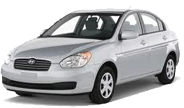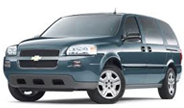FAQ
In a variety of car rental websites I often (if not always) see the vehicle “classes”. Who set these classes? Car rental companies?
To allow for a uniform classification and easy comparison of car rental prices, the Association of Car Rental Industry Systems and Standards (ACRISS) has developed the ACRISS Car Classification Code coding system. This describes the size, door count, gearbox type (manual/automatic) and whether the car is air-conditioned, encoded into four letters. Additional classifications based on seat numbers and trunk volume in order to provide a unified system for assessing the car types in online reservation systems such as Amadeus or Argus.
What does “Economy Class Vehicles” mean?
According to the car classification, we are talking about the supermini/subcompact and compact/small family types of cars.
- A supermini is a British term that describes automobiles larger than a city car but smaller than a small family car. This car class is also known as the B-segment across Europe, and as subcompact in North America. Superminis have three, four or five doors and are designed to seat four passengers comfortably. Current supermini hatchbacks are approximately 3900mm long, while saloons and estate cars are around 4200mm long. Today, superminis are some of the best selling vehicles in Europe.
- A compact car (North America), or small family car (UK), are larger than a supermini but smaller than or equal to a mid-size car. The term often leads into confusion, however, since international compact cars are somewhat larger than their North American equivalents, mostly because no supermini/subcompact size is manufactured by American, Mexican and Canadian car makers at this time. This car class is also known as the C-segment across Europe. Current compact car size is approximately 4,100mm (161in) and 4,450mm (175in) long for hatchbacks, or 4,400mm (173in) and 4,750mm (187in) long for convertibles, sedans (saloon). Common engines are 1.5 to 2.4-litre straight-4s, using either petrol (gasoline) or diesel fuel, with a range between 100hp (75kW) and 170hp (127kW). Some models also have economical 1.3 or 1.4-litre units. Small family cars include the Ford Focus, Opel Astra, Fiat Bravo, Volkswagen Golf Mk6, Honda Civic, Mitsubishi Lancer, Nissan Bluebird Sylphy, Mazda3, Subaru Impreza, Suzuki SX4, Hyundai Elantra, Kia Forte, and Toyota Corolla, Chevrolet Cruze, Pontiac G5, Dodge Caliber and many others.
What does “Full Size Class Vehicles” mean?
Large family/mid-size cars have room for five adults and a large trunk (boot). Engines are more powerful than small family/compact cars and six-cylinder engines are more common than in smaller cars. Car sizes vary from region to region; in Europe, large family cars are rarely over 4700mm long, while in North America, Middle East and Australasia they may be well over 4800mm. Examples of large family cars/mid-size cars include: Chevrolet Malibu, Hyundai Sonata and many others. This term Full-Size Car is used most in North America, Middle East and Australia where it refers to the largest sedans. Full-size cars may be well over 4900mm long and are the roomiest vehicles. Examples of full-size cars: Dodge Charger, Chevrolet Impala, Toyota Avalon.
What is minivan? How many people can it carry?
Minivans are typically either two-box or one box designs for maximum interior volume. MPVs are usually between 1,600-1,800mm (63-71in) tall, which is around 200mm (8in) taller than a sedan, hatchback, or a station wagon. Worldwide, minivans are also marketed as multi-purpose vehicles (MPVs), multi-utility vehicles (MUVs), people-carriers or people-movers. The engine is mounted very close to the front edge of the van, and its elements are grouped higher than in other vehicle types to minimize front overhang length. The rear overhang may be short as in a hatchback or long like in station wagons, changing the cargo area vs seat balance – the first option is more common in smaller minivans and the second in large minivans. Larger MPVs usually feature three rows of seats. Seats are located higher than in lower cars, giving passengers a more upright posture and providing more legroom. The most common large size configuration is 7 passenger seating.
SUV – What is it?
SUV is an abbreviation from Sport Utility Vehicle. A Standard SUV has room to seat 5 passengers and has a split rear seat for hauling bulky items. A sport utility vehicle, SUV, is off-road vehicle with four-wheel drive and true off-road capability. They most often feature high ground clearance and an upright, boxy body design. Examples of SUVs: Land Rover Discovery and Jeep Grand Cherokee. Crossover SUVs are derived from an automobile platform using a monocoque construction with light off-road capability and lower ground clearance than SUVs. They may be styled similar to conventional “off-roaders”, or may be look similar to an estate car or station wagon. Examples of crossover SUVs include: BMW X5; Chevrolet Equinox; Lexus RX
What is a GPS automotive navigation system?
The Global Positioning System (GPS) is a space-based satellite navigation system that provides location and time information in all weather, anywhere on or near the Earth, where there is an unobstructed line of sight to four or more GPS satellites. It is maintained by the United States government and is freely accessible to anyone with a GPS receiver. A GPS automotive navigation system is designed for use in automobiles. It typically uses a GPS navigation device to acquire position data to locate the user on a road in the unit’s map database. Using the road database, the unit can give directions to other locations along roads also in its database. Dead reckoning using distance data from sensors attached to the drivetrain, a gyroscope and an accelerometer can be used for greater reliability, as GPS signal loss and/or multipath can occur due to urban canyons or tunnels.
GPS navigation systems may (or may not) use a combination of any of the following:
- top view for the map
- top view for the map with the map rotating with the automobile (so that “up” on the map always corresponds to “forward” in the vehicle)
- bird’s-eye view for the map or the next curve
- linear gauge for distance, which is redundant if a rotating map is used
- numbers for distance
- schematic pictograms
- voice prompts
Why it is good to have a GPS unit in a rental car?
It gets you through those unknown territories saving you loads of time during your travel. A GPS can be attached in your car while you are driving. If you make a wrong turn it will correct you and get you back on route. Nice and easy. Just program the places that you want to go into the GPS and then follow the vocal instructions. The GPS will give you accurate and detailed directions with realistic arrival times. It’s much easier than a map because there is no need to stop to find out where to go next. Go in confidence and safety knowing your GPS will always get you where you want to go and get you back safely.
What are the regular rental conditions?
Car rentals are subject to many conditions which vary from one company to another. Generally the vehicle must be returned in the same condition it was rented in, and often must not exceed mileage restrictions, otherwise extra fees may be incurred. For insurance reasons, some companies stipulate a minimum and/or maximum rental age. In all cases a valid driver’s license is required in order to rent a vehicle. The majority of car rental companies require the use of a credit card to charge additional fees should a defect be found with the car on its return or for road tolls, motoring related fines or missing fuel. In lieu of a credit card some companies require a large cash deposit.
What are the minimum age requirements for a person to rent a car?
You must be at least 21 years old to rent a car from CarRentalToronto4U. There some provisions may apply for customers between the ages of 21-24, such as: an additional per day underage surcharge; screening of your driving records; acceptable credit card and a valid driver’s license both in your name; you will not be permitted to rent 7-passenger mini vans, specialty vehicles, and full-size SUVs; if you want to add an additional driver to the rental policy, the second driver must be 25 or older and some other conditions.
Should I sing a Car Rental Agreement?
Yes. You will be required to agree to and sign a Car Rental Agreement at the office when CarRentalToronto4U releases a rental car to you.
What kinds of credentials will I need to present to rent a car?
All drivers must present a valid U.S.- or Canadian-issued driver’s license in the driver’s name; one of the major credit cards (Visa, MasterCard, American Express); car insurance policy (if any).
Will I have to give a deposit to rent a vehicle?
Yes. Usually your credit card information will be used for security purposes.
Will I be allowed to rent a car from CarRentalToronto4U if I have convictions in my driving records?
It depends. CarRentalToronto4U might check your and additional drivers’ licenses to ensure that they are valid. CarRentalToronto4U is unable to rent if the driving records reveals any of the following issues:
- invalid, suspended or revoked license
- one or more convictions for reckless driving within 36 months
- one DUI, DWI or DWAI conviction within 48 months
- failure to report an accident/leaving the scene of accident within 36 months
- possession of stolen vehicle or use of a vehicle in a crime
- expired license
- three or more convictions for moving violations within 24 months (excluding seatbelt violations)
- three or more accidents within 36 months
Can someone else drive a car that I rent?
Yes. An additional driver must be at least 25 years of age. We will check the additional drivers’ license to ensure that it is valid.
What is the financial responsibility of an additional driver?
Usually, when someone rents a car, they assume full financial responsibility for the vehicle.
Cannot find a question you want to ask? Give us a call!
Car Rental Toronto 4U provides clean, reliable, late model used cars, pickup trucks, vans, minivans, and sport utility vehicle or SUV for short or long term vehicle rental and lease. Always check with www.CarRentalToronto4U.ca for moving, business needs, vacation car and pickup truck rentals, college and university special student rates for Toronto car rental.



